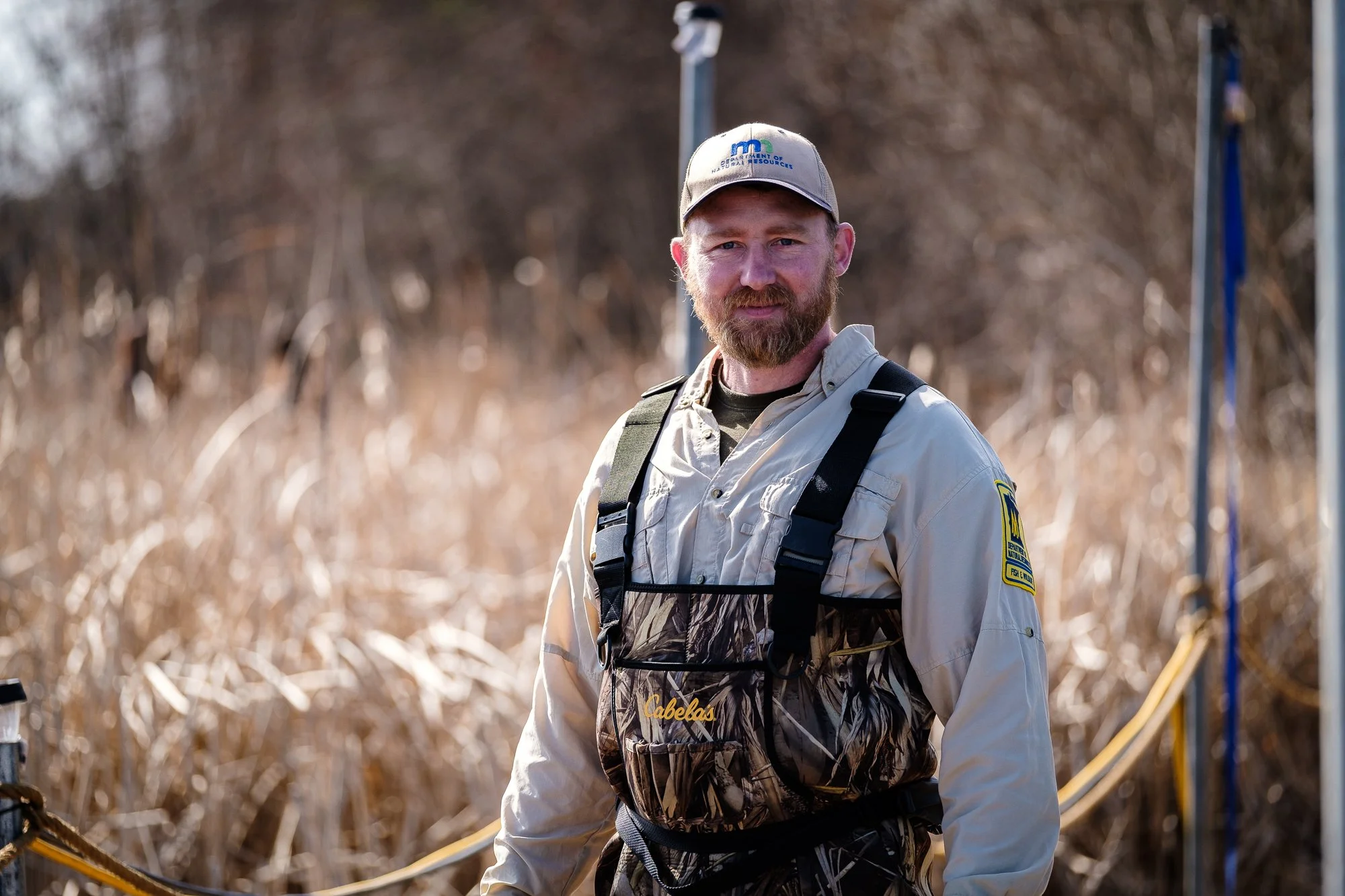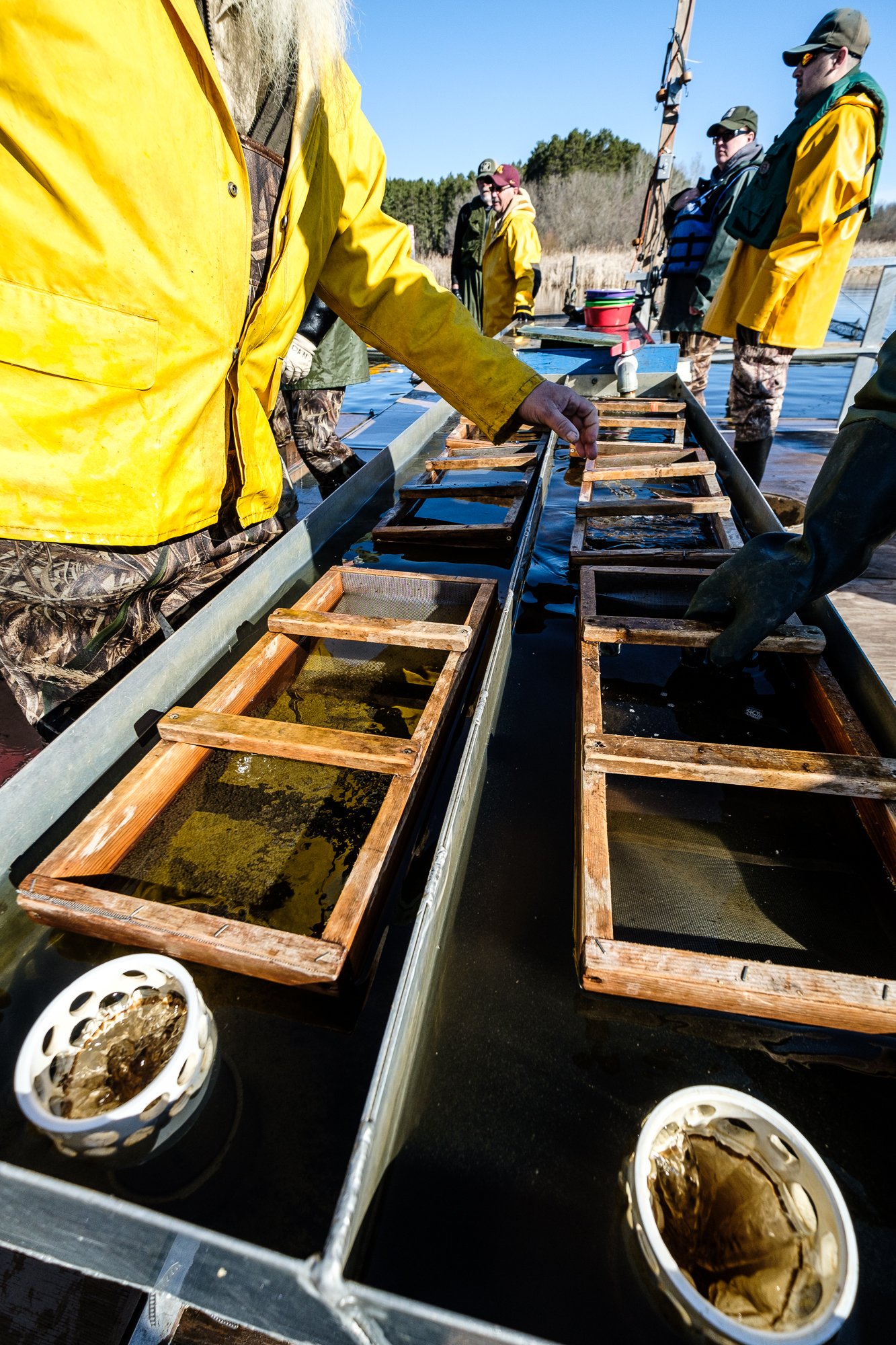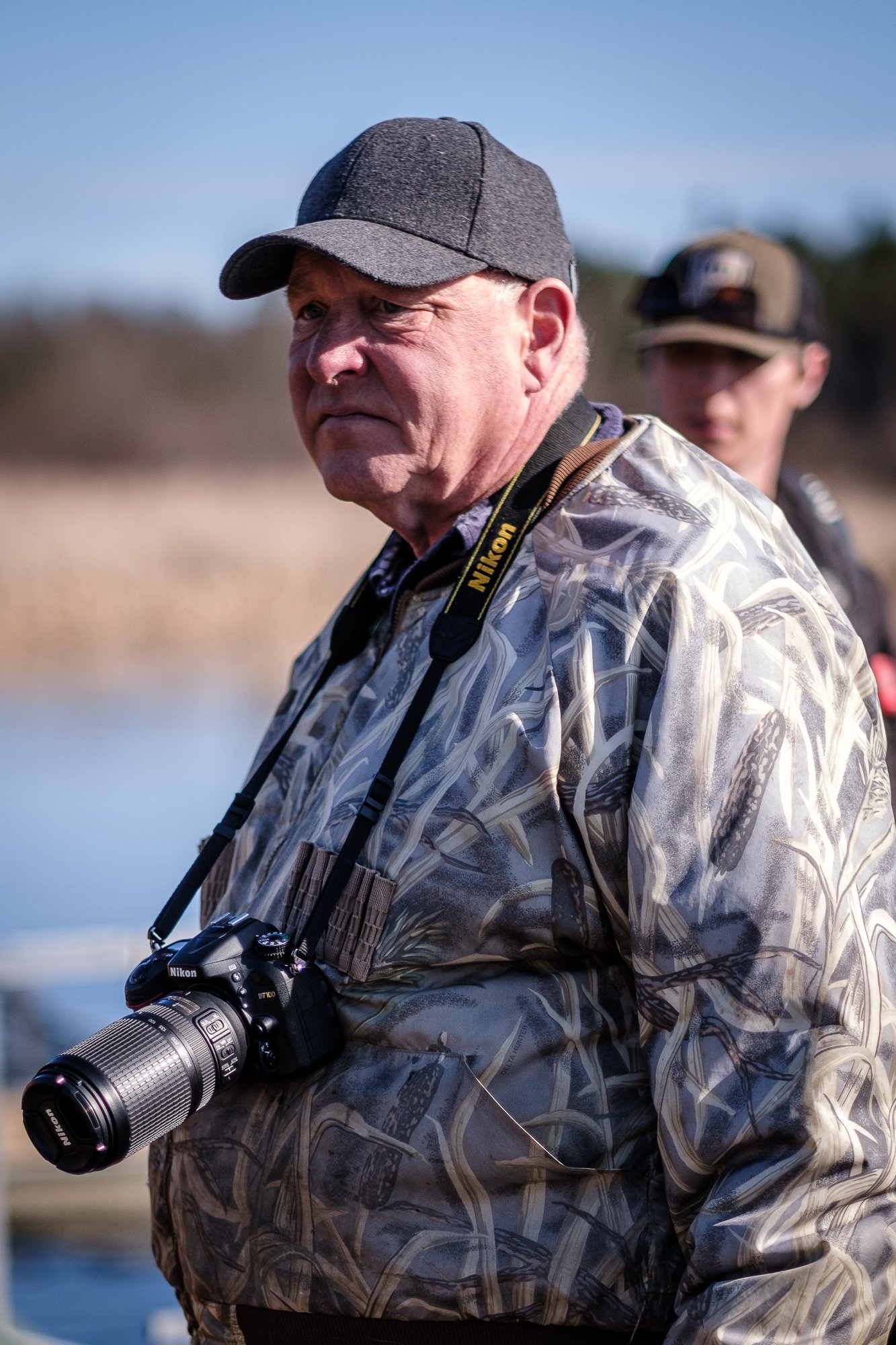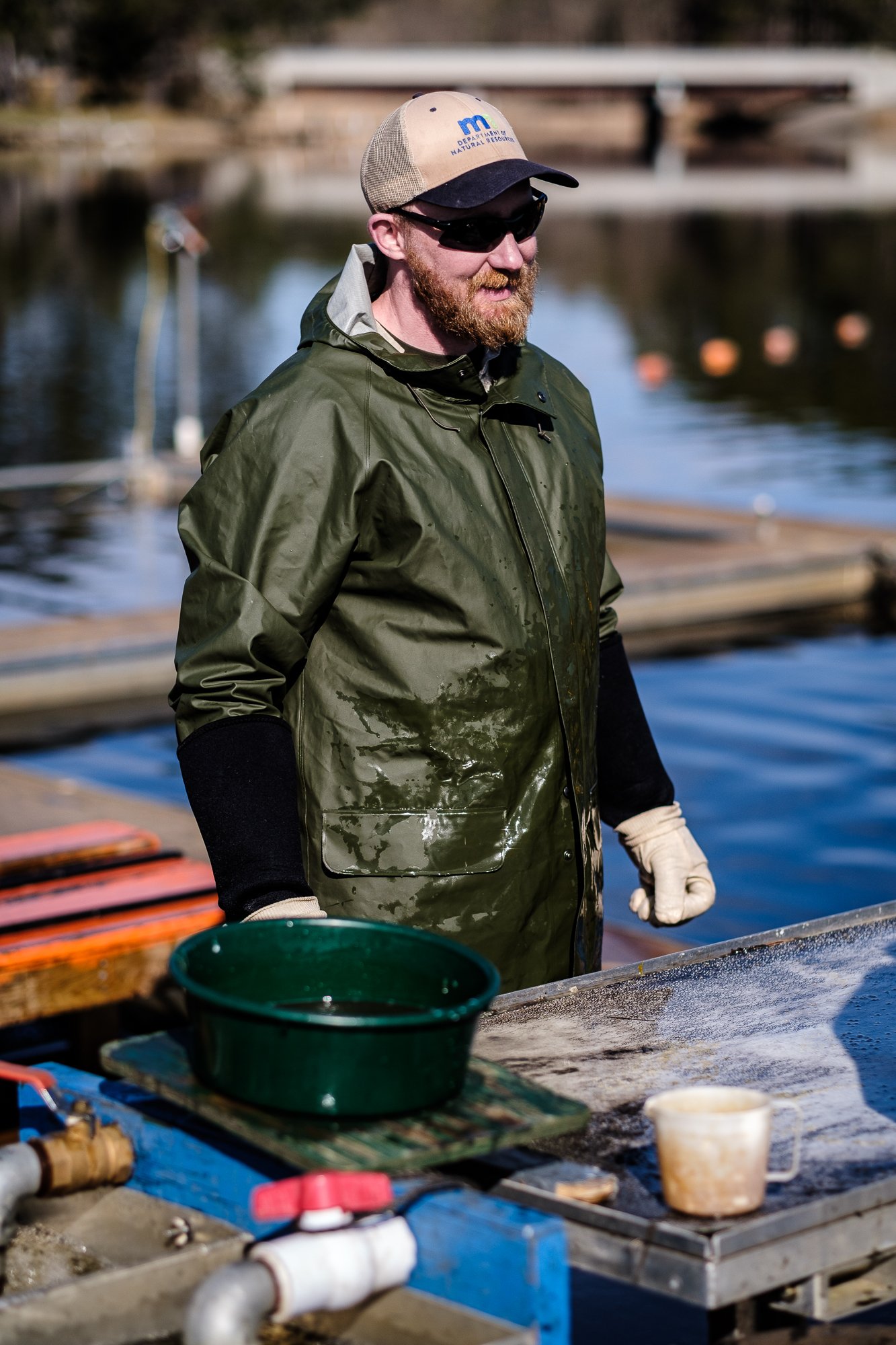While a dusting of snow this morning would suggest otherwise, spring has definitely arrived early in northern Minnesota. The expanse of ice has left Lake Winnibigoshish, robins are on the hunt for worms and our maple trees’ telltale red buds are brightening an otherwise dreary landscape. Another spring event is the DNR’s annual walleye spawning site on Cutfoot Sioux Lake, where the state’s biologists collect eggs that will be fertilized, hatched, released into our fishery, as well as others throughout Minnesota.
Open to the public, the enormous quantity of walleyes collected in the pens is undoubtedly a spectacle. While it is an annual event, but pandemic restrictions and late springs/ice outs have limited or entirely prevented the work from being conducted over the past several years. Lake Winnibigoshish has tremendous potential for natural walleye reproduction due to its sand and gravel bottom so though it is important work, it is not necessarily critical for the success of the fishery. Walleye fry that are released in lakes without great natural reproduction, however, can significantly benefit from the stocking program. There is one certainty from witnessing all the fish in those pens; the number of trophy walleyes in the water is far more than we realize.
A new face at the pens is Dan Schermerhorn, Lake Winnibigoshish’s new large lake specialist, or lead biologist. At Bowen Lodge, we value a strong relationship with the biologists that study our cherished body of water, as it gives us a deeper understanding of the intricacies in this ever changing, complex ecosystem. We caught Dan for a rare moment when he wasn’t juggling egg-laden walleyes for an opportunity to get to know Dan and gain some insight on the spawning nets. With some luck, you’ll be catching the fish they hatch and release in Lake Winnibigoshish over the next few years.
Want to plan your next Minnesota fishing vacation? Contact us to learn why Bowen Lodge is the true northwoods experience.
Visitors look on as DNR biologists strip and fertilize eggs from walleyes at the Cutfoot Sioux spawning station.
Can you tell us a little about yourself?
I grew up near Detroit Lakes where I developed my interest in aquatic sciences while fishing, trapping my own bait, and playing in lakes and rivers. I attended the University of North Dakota for fisheries biology. After graduation, I worked for Wyoming Game and Fish and a fish research lab in Illinois before landing my first job with the Minnesota DNR in International Falls as a fisheries specialist. During my eight years in International Falls, I spent a lot of time on Rainy Lake, which sparked my interest in our large lake program. I was the assistant supervisor of the Mille Lacs office for about two years before finally landing my job in the Grand Rapids office in 2023.
What is your role with the DNR on Lake Winnibigoshish?
My title is large lake specialist. In 1983, the department created the Large Lake Program to monitor the ten largest walleye lakes in the state and each management area with a large lake was staffed with a dedicated biologist to focus on that lake. Each year, I do surveys to monitor things such as water quality, zooplankton, juvenile fish, and the current status of our popular gamefish. We also do creel surveys periodically to track angler pressure and harvest rates. Outside of Winnie, I also survey the connected lakes (Cut Foot Sioux and Little Cut Foot Sioux) as well as assist with surveys on the hundreds of other lakes in the Grand Rapids management area.
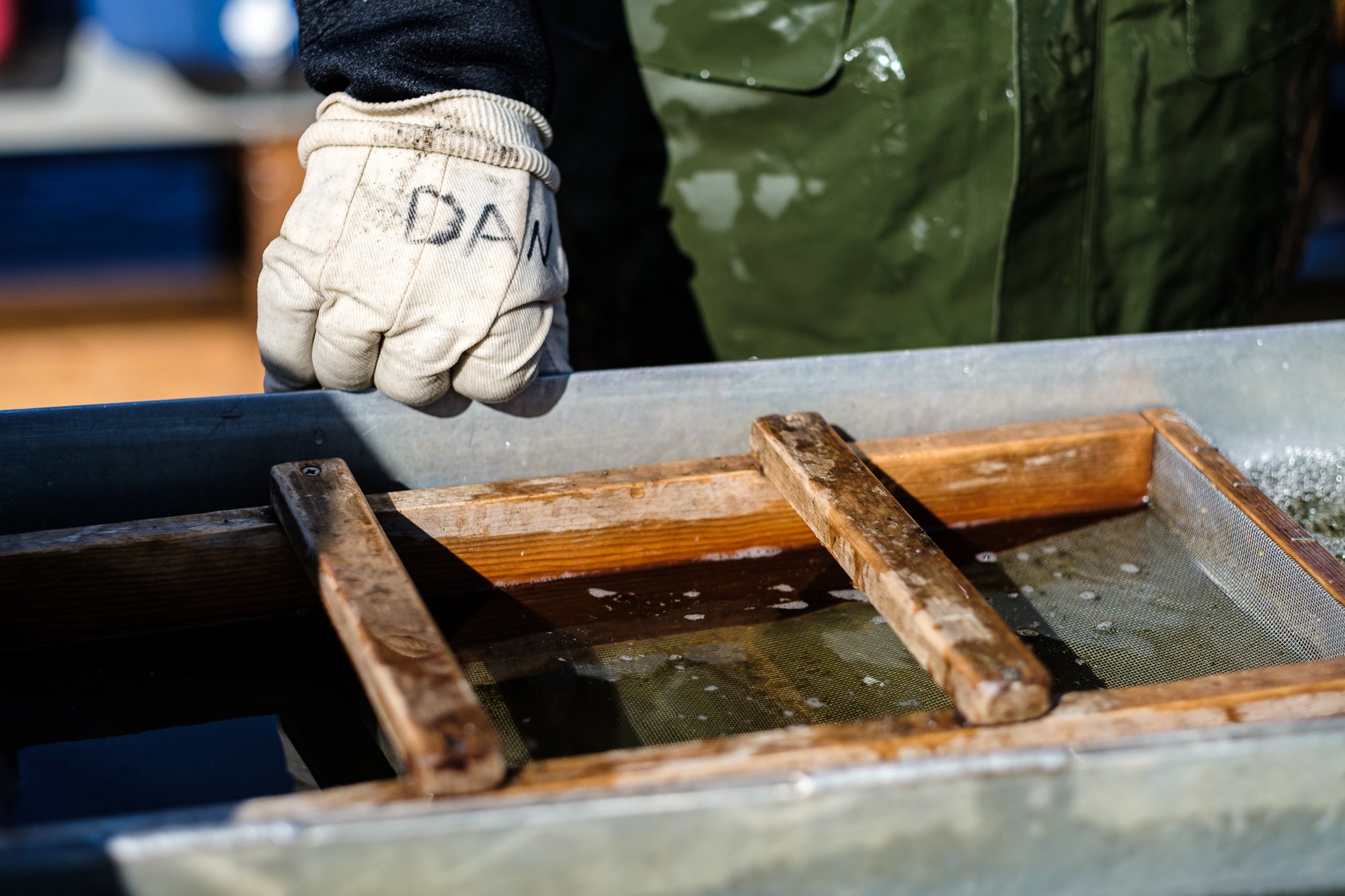
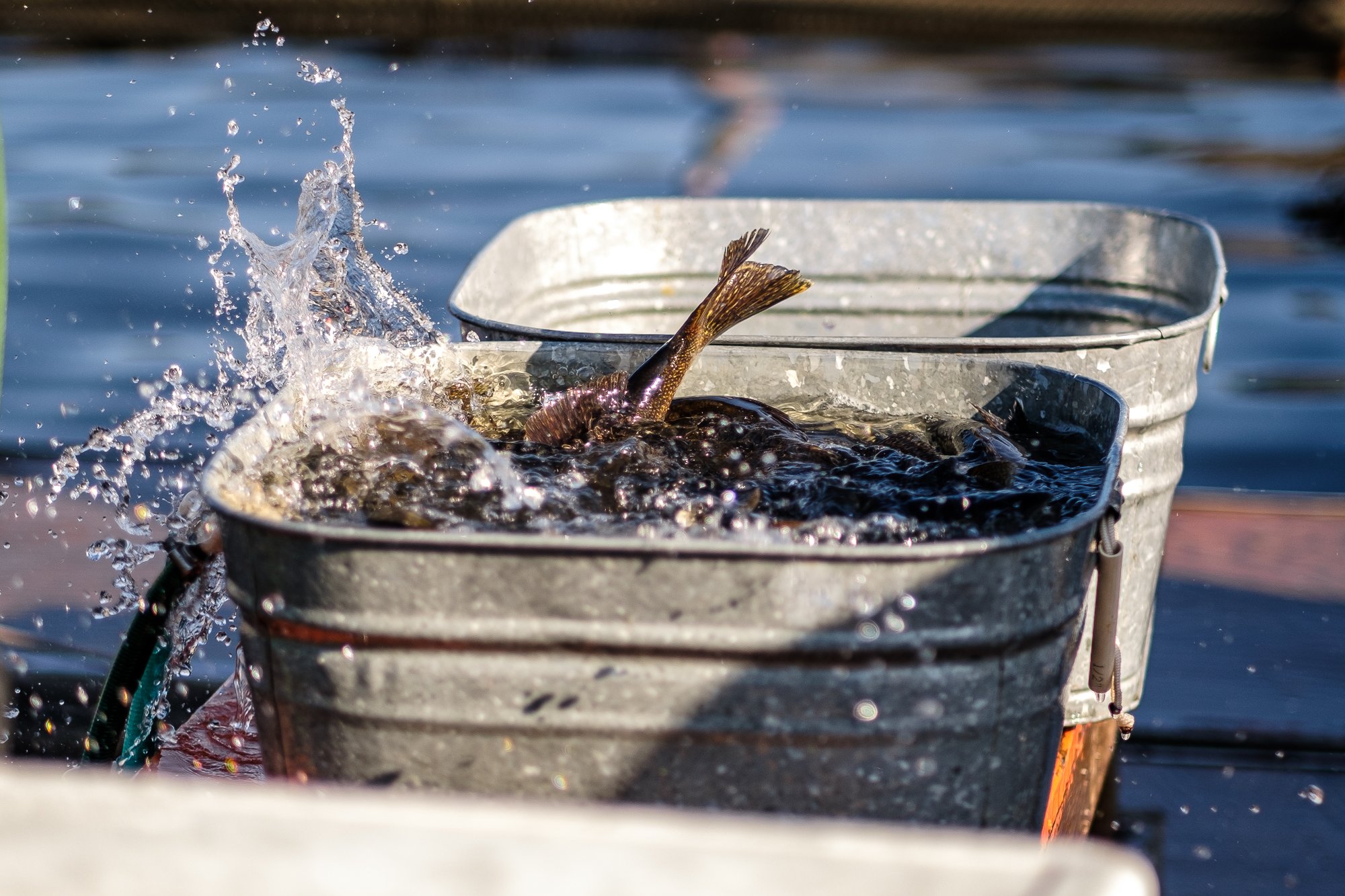
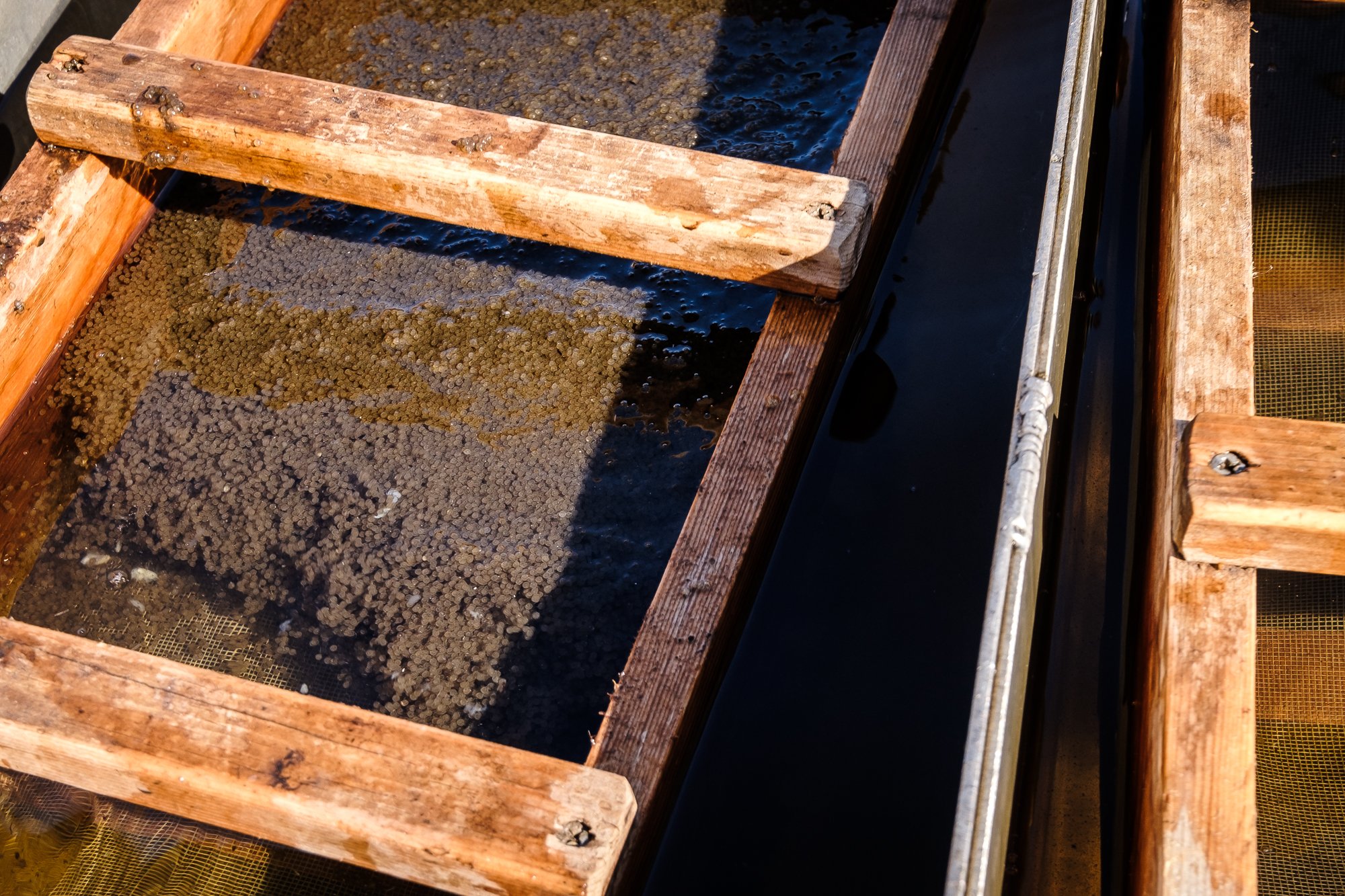
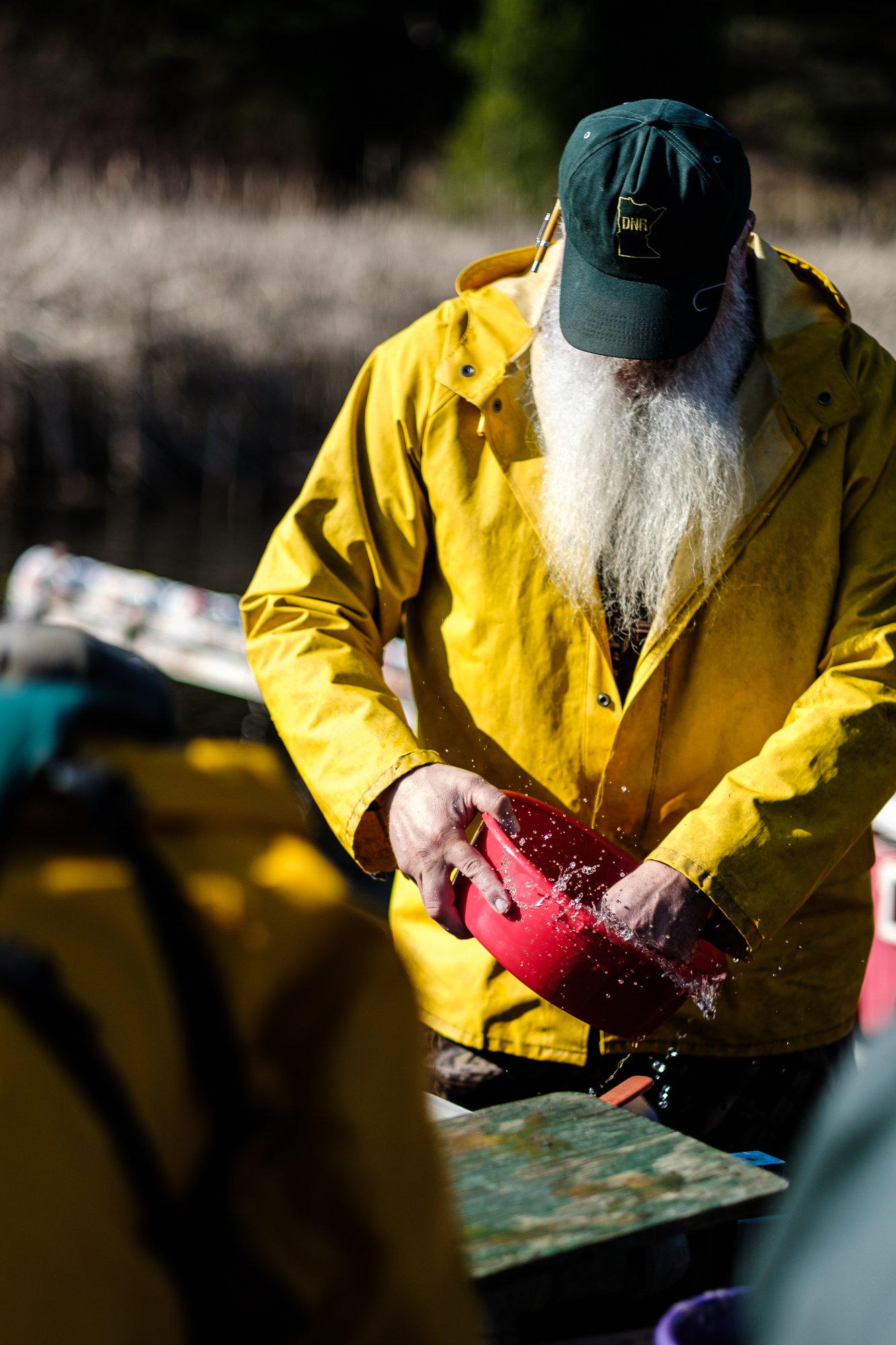
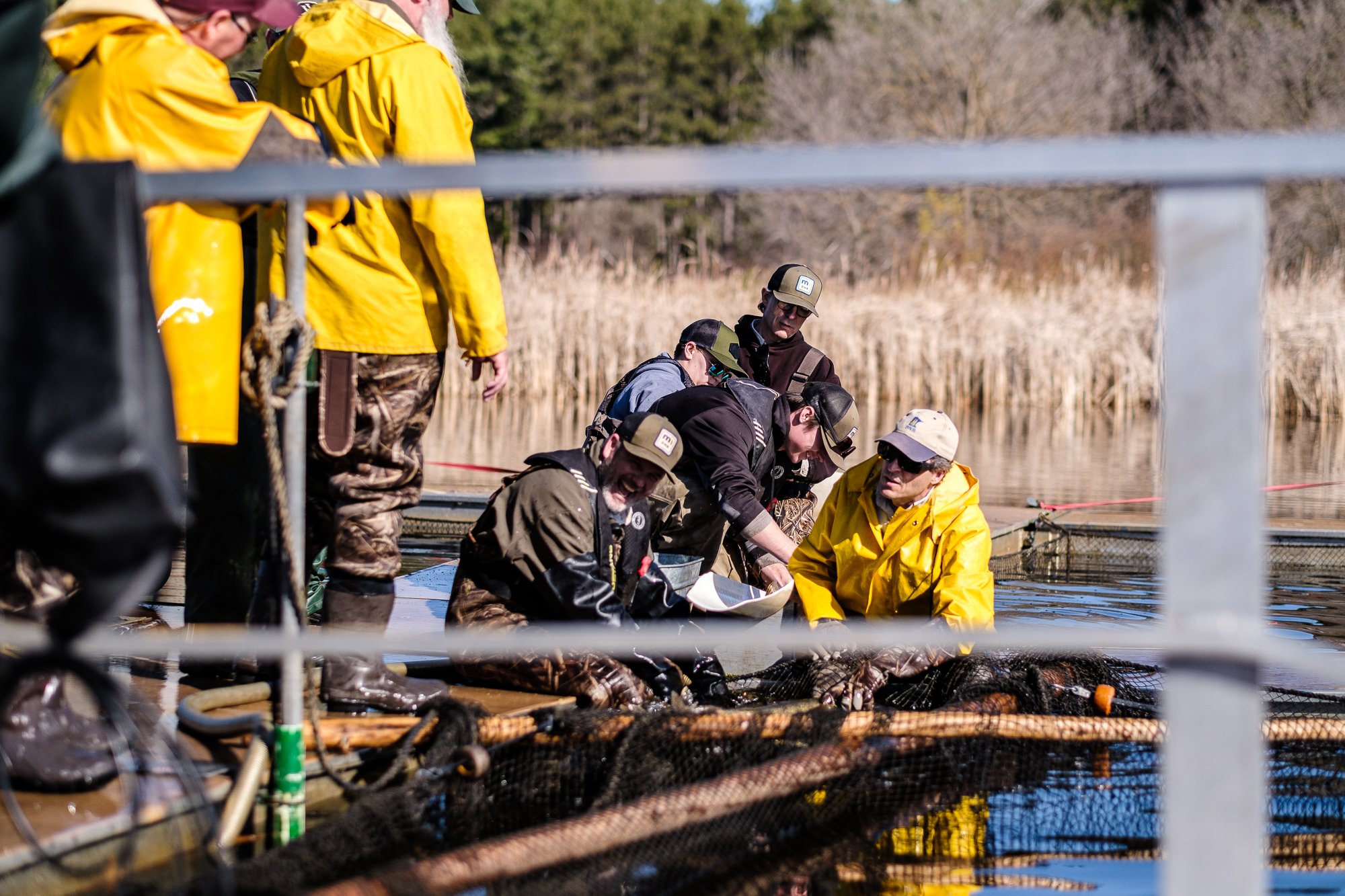
Can you explain the process of what is happening on Cutfoot Sioux Lake today?
We install a temporary fish trap here shortly after ice melt, as there is a large run of walleye that move through this area. Walleye naturally swim up current looking for suitable spawning habitat in the spring. The habitat upstream of this site is not going to provide them much opportunity to successfully spawn, but fortunately we are able to pick them up in the trap, collect and fertilize the eggs right here on the dock, and immediately return them to the lake. The eggs and milt are mixed in a pan before being mixed with mud to coat the eggs so they don’t stick together. After the eggs have been rinsed they will harden for a couple of hours before being transported to a hatchery where they will hatch at a much higher success rate than they would have achieved naturally.
Does this process hurt the fish?
Our trap basically involves directing the fish up a large funnel into a holding pen. The fish never spend more than about 24 hours in a holding pen before we sort them to see which fish are ready to spawn. Walleye that are “ripe” and ready to spawn will release their eggs or milt simply by giving them a squeeze while another worker catches the product in a pan for mixing. After collecting the eggs, the fish are immediately released live into the lake above the trap so they can’t be caught again. The amount of time spent out of the water is similar to about how long it would take an angler to remove a hook, and because the water temperatures are so cold, mortality of any sort is typically very low. We also keep at least one staff member at the trap 24/7 to watch for things like debris fouling the trap, or hungry pelicans trying to steal fish.
Walleyes are intercepted on their way to spawn and trapped in these large pens, where females and males are later sorted and separated.
With each sex separated, the biologists check for females that are ready to release their eggs with a gentle squeeze. “Ripe” fish are then set aside to be stripped, while “green” fish are put back in the water to get some more time to spawn.
Are the biologists collecting any other data or conducting tests on the fish?
Yes, we collect ovarian fluid from a small subsample of fish to test for a disease called Viral Hemorrhagic Septicemia (VHS) to make sure it is safe to stock fish hatched from these eggs into other lakes. Other research needs can come up in certain years. For instance, this year we clipped a small piece of fin from a sample of fish that will go to a lab for genetic testing. Beyond that, we are just counting the number of walleye and handling them as little as possible.
What happens to the eggs after leaving the lake?
We bring them to our hatchery in Grand Rapids. The eggs are placed in jars with a steady flow of fresh water and are cared for—24/7—until they hatch, about three weeks. With the collection methods we use and the ideal conditions the eggs are given in the hatchery, in recent years we are successfully hatching close to 70% of the eggs. In nature, these eggs would have typically had far less than a 1% chance of successfully hatching so we have the ability to put back more in Winnie and the Cut Foot Sioux lakes than would have hatched naturally, and still have a large surplus to stock into other lakes. The newly hatched fish are called fry, and they are typically the day after they hatch so they are able to begin feeding in their new home as soon as possible.
What excites you about working on our lake?
I love big lakes and having a job where I get to focus on working on one big system and really get to dive deep into the history of the lake. Winnie has a reputation for being a premier perch and walleye lake. The large lake program was created to monitor walleye, and I will definitely be doing everything I can to monitor the walleye population. I also think we have a lot to learn about bass, panfish, muskie, and even tullibee and burbot, and I look forward to learning more about those species in the lake as well!
Click here for more information on the work being conducted on Cutfoot Sioux Lake.
Want to join us at Bowen Lodge this summer? Contact us for our current availability and begin planning your next northern Minnesota adventure

